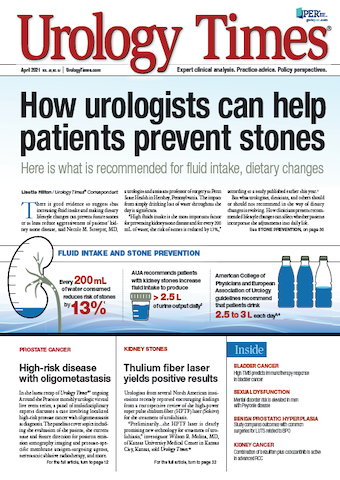Publication
Article
Urology Times Journal
Was this patient with stones properly informed of bladder mass?
Author(s):
Jury apportions fault among the plaintiff as well as the defendants.
Acacia Brush Perko, Esq

On October 23, 2015, the plaintiff, a 49-year-old man, presented to the emergency department complaining of back and flank pain. A physician and a third-year resident treated him. The patient underwent a CT scan, which confirmed the presence of kidney stones.
In his report, the interpreting radiologist also described the presence of a 2.7-cm mass in the bladder. The resident informed the patient only about the kidney stones. The patient was discharged, with written instructions describing “kidney stones” and advising him to follow up with a urologist within 5 days. The patient passed the kidney stone the next day, and never followed up with a urologist. The patient had no further symptoms until the end of 2016, when he began experiencing incontinence and erectile dysfunction. By February 2017, the patient finally saw a urologist; the urologist sent him for an ultrasound.
The radiologist interpreted the 2017 ultrasound and compared it to the 2015 CT scan. The radiologist reported that the mass was now considerably larger. It was so large that it occupied almost the entirety of the bladder. A biopsy confirmed the mass was malignant.
In May 2017, the patient began chemotherapy to shrink the mass. A cystoscopic procedure was attempted, but the mass was too large to be extracted. In July of that year, the patient’s bladder and prostate were removed. To replace his bladder, a piece of his colon was removed and sutured to create a pouch that was then connected to his ureter and urethra.
The patient and his wife brought a medical claim against the hospital, emergency department physician, and the resident, claiming the defendants failed to inform the patient about the mass seen on the 2015 CT, which led to delayed cancer diagnosis and subsequent surgeries, including removal of his bladder and prostate. The defendants all denied negligence, and the matter proceeded to trial.
Patient testifies about bladder issues, erectile dysfunction
At trial, the patient testified that no one informed him about the mass seen on the 2015 CT scan during the emergency department visit. He testified about his bladder issues and how he suffered erectile dysfunction. He described intense mental distress, for which he had sought treatment, a disruption of his normal activities, and occasional incontinence. He sought damages for past and future pain and suffering.
The patient’s wife testified that no one informed her about the mass while they were at the hospital in 2015. The wife also testified about her husband’s erectile dysfunction and its consequent problems—such as the couple’s lack of intimacy—that affected the marriage. She sought damages for loss of consortium.
The plaintiff’s emergency department physician expert testified that the defendants were negligent for failing to verbally tell the patient in an adequate and transparent manner about the mass finding on the CT scan, and for failing to ensure that he understood the finding. At the time of trial, the patient continued to be monitored by his urologist. The patient’s treating urologist explained how the size of the tumor at the time of diagnosis prevented simple local resection.
The plaintiff’s urology expert testified that the patient remained at risk of developing recurrent cancer or metastatic disease. The urologist also testified as to metabolic abnormalities associated with the makeshift bladder, which could lead to other problems. The urologist expert testified that had the malignant mass been diagnosed properly in October 2015, it would have been removed cystoscopically, and the patient’s bladder and prostate would have been saved.
During the defense presentation, the defense emergency physician expert testified that the defendants’ care was reasonable, that the patient was informed in writing of the kidney stones, told about the mass, and instructed to follow up with a urologist. The defense expert further testified that patients are expected to follow their physicians’ orders, and that the patient was comparatively negligent for failing to follow the instructions to see a urologist.
Following a 7-day trial, the jury returned a $10 million verdict for the plaintiff. The jury apportioned fault and found the resident 60% liable, the emergency department physician 25% liable, and the patient 15% liable. Accordingly, the award was reduced to $8.45 million.
LEGAL PERSPECTIVE: Many states allow a plaintiff who is partially at fault to still recover, so long as their fault does not exceed the fault of defendants. In this instance, the jury found the patient partially to blame for his failure to follow his physician’s instructions. But, because his fault did not exceed that of the defendants, he was still entitled to recover on his medical claim.
Perko is an attorney in the Columbus, Ohio office of Reminger Co., LPA, where she specializes in medical malpractice defense litigation and transactional matters. She welcomes your feedback on this column at APerko@reminger.com.

Newsletter
Stay current with the latest urology news and practice-changing insights — sign up now for the essential updates every urologist needs.






























